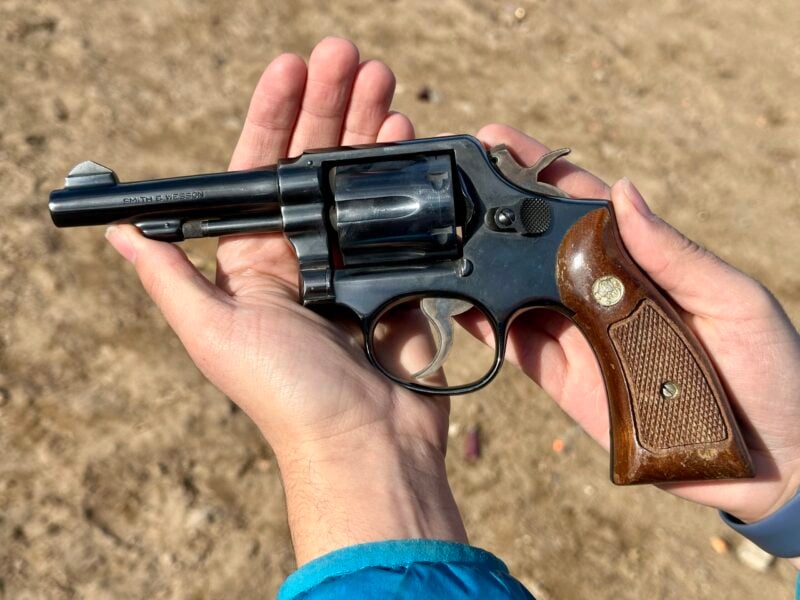Smith & Wesson Visit Heightens
Connection Of Industry To Conservation
A few years ago, I enjoyed a guided toured of the Smith & Wesson factory in Springfield, Mass. A headset protected my hearing from the rumble of industry, while the voice of my tour guide bled through via radio.
Through a fuzzy static, he explained much of the factory built the firearms through automation. I had anticipated a factory floor with a multitude of workers at benches with lathes and mills and grinders. Instead, the guide led me through a cluster of a dozen taupe-colored pods, each two-thirds the size of a VW bus turned on its end.
Each pod contained a machine. Through small glass portals I watched milled steel being rendered into firearm parts.
A worker moved from pod-to-pod checking readouts that showed the life left on diamond-tipped tools that cut steel. Save for maintenance or repairs, my guide said the mills, presses and forges operated around the clock.
We moved by a Smith & Wesson Model 10 revolver display. The dust-covered board showed the progression from raw steel to the formation of the revolver’s constituent parts, and how they fit together to form a fine firearm. The Model 10 has been in production for 125 years.
I had to pause. I felt a stirring that doesn’t quite have a name.
Factory-Inspired Flashbacks
I inherited my dad’s Model 10 at his passing a decade earlier. I was already well acquainted with the firearm. He taught me how to properly handle a handgun as a boy with that revolver. He bought the firearm at the crescendo of America’s bicentennial in the Spring of 1976 — I’m sure partly out of patriotic sentiments.
Dad was no stranger to firearms, as a hunter and target shooter. As a young soldier, he defended liberty with an M1 and a 1911 on the brutal front lines in North Korea in 1951.
In any one of the Smith & Wesson workers I could see my late brother, a machinist. He was an inventive man who concerned himself with precision and fineness in fabrication.
Throughout the tour I heard muffled mallet on metal, squeaky rubber wheels, a rhythmic tick, the jetting spray of fluids, and pounding of a pneumatic forge on hot steel.
The sounds of industry turning the raw into the refined, transforming ingots in to machined art, aroused thoughts far removed from the moments in Massachusetts.
In recesses of my memory, I heard the tink, plinking peach cans with my dad’s .22 semi-auto. Fat raindrops patter the forest floor as my brother whispers at me in the squirrel woods, pump shotguns in hand. My daughter hollers “There they go!” at the lumbered lift of 3 lb. dusky grouse rising amid hummocks of last summer’s exhausted high-country grasses. The thump-thump press of my 20-gauge over/under shotgun on my shoulder comported with the thick pounding of a factory forge.
Securing Wildlife Conservation, One Purchase At A Time
Manufacturing firearms, ammunition, and archery gear secures wildlife conservation. Since the passage of Pittman-Robertson in 1937, state fish and wildlife agencies have had a steady, reliable conservation funding source originating from the 10 to 11% excise tax that manufacturers pay at the first sale of their products.
That’s $1.1 billion per year as of late that is apportioned to state fish and wildlife agencies, which pays for the scientific management of more than 500 species of creatures furred and feathered — including wildlife disease monitoring and research.
Pittman-Robertson dollars fund 792 public target ranges across the country and pays for the purchase and management 48.6 million acres of public wildlife management areas and game lands where people hunt, trap, fish, and immerse themselves in the natural world. In the aggregate that’s an acreage nearly equal to that of South Dakota.
Beneath the busy pods on the Smith & Wesson floor, machines and the people who take care of them shape steel into enduring products that in short order will contribute to conservation in no small measure.
Conservation is an investment in the future and made possible by an enduring law that stands as a testament to a partnership between American manufacturers, state and federal governments — and the people who hunt and shoot and enjoy being in nature.
To learn more about conservation and target range funding, visit Partner with a Payer: www.partnerwithapayer.org.
Editor’s Note: Craig Springer is a biologist with USFWS.





